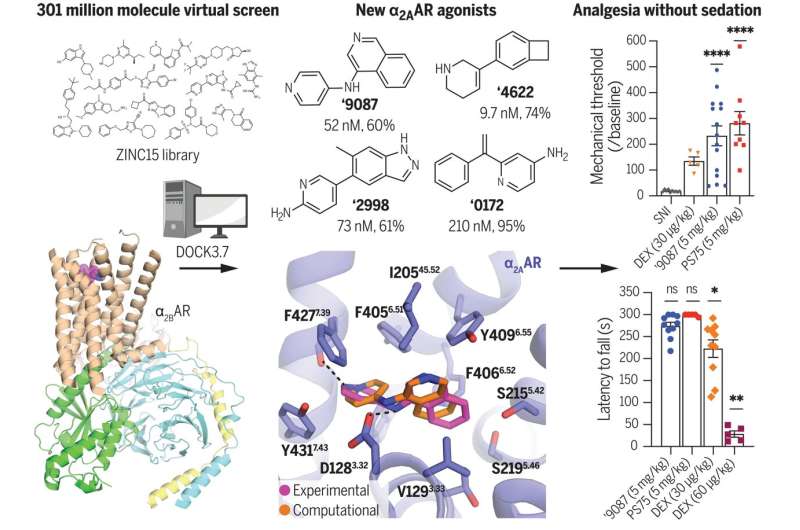Newly identified α2AAR agonists are analgesic without sedation.More than 301 million molecules were docked against the activated α2BAR. Experimental testing identified α2AAR agonists with diverse chemical scaffolds. The experimental structure of the ‘9087-α2AAR complex superposed closely to the computational prediction. The newly discovered agonists had efficacy in an in vivo neuropathic pain model (top right) without sedation, unlike dexmedetomidine (DEX) (bottom right). Gi1-activation EC50 (nanomolar) and Emax (percentage) values are shown. Single-letter abbreviations for the amino acid residues are as follows: D, Asp; F, Phe; I, Ile; S, Ser; V, Val; and Y, Tyr. ns, not significant; *P < 0.05; ****P < 0.0001; SNI, spared nerve injury. Credit: Science (2022). DOI: 10.1126/science.abn7065
A newly identified set of molecules alleviated pain in mice while avoiding the sedating affect that limits the use of opiates, according to a new study led by researchers at UC San Francisco. The molecules act on the same receptor as clonidine and dexmedetomidine—drugs commonly used in hospitals as sedatives—but are chemically unrelated to them and may not be addictive.
Clonidine and dexmedetomidine are also both effective pain killers but so sedating that they are rarely used for pain relief outside of the hospital.
"We showed that it's possible to separate the analgesic and sedative effects related to this receptor, said Brian Shoichet, Ph.D., professor in the School of Pharmacy, and one of four senior authors of the study, which appears in the Sept. 30, 2022, issue of Science. "That makes it a very promising target for drug development."
The research began shortly before the COVID-19 pandemic, with the aim of finding effective painkillers that can be used together or in conjunction with opioids.
The work brings together researchers from a variety of disciplines; Shoichet's co-authors include UCSF anatomy chair Allan Basbaum, Ph.D., chemist Peter Gmeiner of Freidrichs Alexander University in Germany, structural biologist Yang Du, Ph.D., of the Chinese University of Hong Kong, and molecular biologist Michel Bouvier, Ph.D., of the University of Montreal.
"Together, we were able to take this from the most fundamental level to identifying new molecules that might be relevant, and then to demonstrating that, in fact, they are relevant," said Basbaum. "That doesn't happen very often."
6 Molecules Out of 300 Million
Shoichet was encouraged to look for substances that would activate this adrenergic receptor, called alpha2a, by Basbaum, who had studied it in his lab and showed that it is tied to pain relief.
To start the search for molecules that would bind firmly to the receptor, Shoichet computationally combed through a virtual library of over 300 million molecules, eliminating those that were too bulky for the small receptor. The remaining thousands were virtually "docked," one by one, on a computer model of the receptor.
Through a series of tests, Shoichet narrowed the field from an initial 48 candidates to six, based on how they bound to the receptor in cultured human and mouse cells. Each of the final six was tested on three different mouse models for acute and chronic pain, and successfully alleviated pain in all three instances.
The pain-relieving molecules, which were from chemically different families, are also entirely novel. None of them had previously been synthesized.
Whereas the older drugs, like dexmedetomidine, activate a broad spectrum of neuronal pathways, the new molecules trigger only a selective subset of these, Shoichet said. The molecules also concentrate in the brain, and bind tightly to the receptor, making them good candidates for further development.
Hope for 1 in 5 Americans
Basbaum cautions that it may take several years of research before any of the compounds could be tested in clinical trials. The researchers don't yet understand possible side effects of the new molecules, and whether there might be unintended consequences from long-term use.
He believes, however, that it's unlikely the compound is addictive. "Substance abuse happens when the drug generates a reward, which we didn't see any evidence of," he said.
While opioids clearly help patients with pain from surgery or cancer, Basbaum noted that the majority of the 50 million Americans with chronic pain have other conditions, like back injuries, joint pain, and inflammatory disease, that often aren't helped by the drugs. New analgesics could completely change the outlook for these patients.
"If we can create a drug that works in combination with a much lower dose of opiate, that would be the dream," he said. "The need for that is huge."
More information: Elissa A. Fink et al, Structure-based discovery of nonopioid analgesics acting through the α2A-adrenergic receptor, Science (2022). DOI: 10.1126/science.abn7065
Journal information: Science
Provided by University of California, San Francisco
























